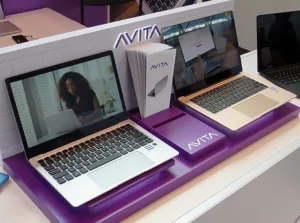CE Week was a two day event (June 20 – 21) at the Javits Center in New York, hosted by ShowStoppers in association with IFA and multiple other organizations. The CTA is not one of the hosts, however. In the evening of June 21, Pepcom had one of its Digital Experience events at the nearby Metropolitan Pavilion. The two events had interesting, display-related new products from both established companies and start-ups. In addition, they both had the normal assortment of gadgets where you scratch your head and wonder.
Avita
Avita America was at CE Week showing its two new laptops, Clarus, which launched earlier this week and Liber which will launch in September. According to Michael Honeycutt, Director of Marketing for Avita Americas, both laptops are targeted at value conscious consumers and both have a MSRP of $699. The Clarus unit is currently available on the Wal-Mart website at a price of $640 and the Liber is expected to be launched on Amazon.
The Liber (left) and Clarus laptops from Avita. (Credit: M. Brennesholtz)
|
Clarus |
Liber |
|
|
Model Number |
CN6314F551 |
CN6212F561 |
|
Screen |
14” FHD (1920 x 1080) IPS |
12” FHD (1920 x 1080) IPS |
|
Computer |
Windows 10 Home, Intel Core i5 processor, 8GB DDR3RAM, Intel HD Graphics 615, All aluminum cabinet, 10 hour battery life. |
|
|
SSD |
128G |
256G |
|
Mechanical |
0.7” Thick, 3.3 pounds |
0.51” thick, 2.6 pounds |
|
Connectivity |
USB-C, Bluetooth, 802.11ac, microSD |
USB-C, Bluetooth, 802.11ac, microSD, USB 3.0×2, miniHDMI |
|
Colors |
Available in silver, matte black and gold |
To be available in angel blue, peacock green, lavender, matte black, silver and blossom pink. |
|
Availability |
Now (Wal-Mart) |
September 2018 (Target) |
|
MSRP |
$699 |
|
|
Credit: Avita, Compiled by M. Brennesholtz |
||
Avita is a subsidiary of Nexstgo Company Limited, which was founded in 2016, which is in turn, a subsidiary of Alco Holdings Limited. Alco uses the Nexstgo brand name for its B2B laptops. The Nexstgo SU series, derived from “ Start-Up”, is a business class laptop PC built and engineered to suit the needs of start-ups and SMBs to the fullest. The Nexstgo SU series laptops were not on display at CE week.
Global Aiptek Corporation
I had a chance to talk to Frank Sheu, CEO of Global Aiptek Corporation. The company was showing its HP-branded pico and micro projectors at CE Week. According to Mr. Sheu, the company uses the Aiptek brand in Europe for its pico and micro projectors. All the company’s projectors use DLP imagers with LED illumination.
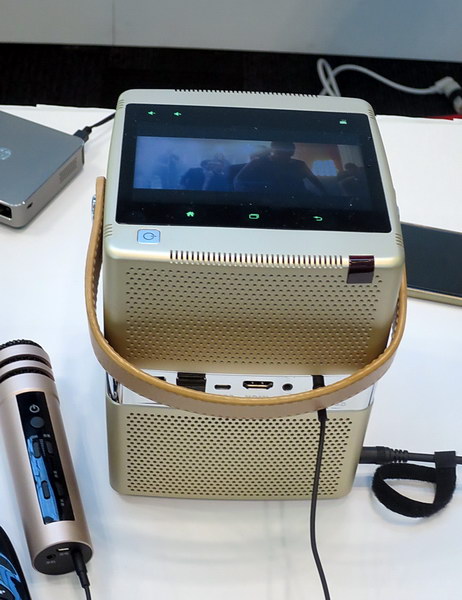 Functioning Prototype of the HP OP800 Omni Projector (Credit: M. Brennesholtz)
Functioning Prototype of the HP OP800 Omni Projector (Credit: M. Brennesholtz)
The company was showing its prototype of the HP OP800 Omni Projector. The “Omni” in the name comes from the term, omnidirectional, and the projector has speakers on all four sides. These total 20W plus there is a sub-woofer. The unit has dual 3.5mm microphone jacks. Mr. Sheu says all this makes it ideal for applications such as karaoke and music videos, as well as other consumer microprojector applications such as movie viewing and gaming. The projector has HD WXGA (1280 x 800) and an output of 800 lumens. The lens throw ratio of 1.2:1 and it has a vertical offset of 100%. The built-in battery has a capacity of 24,000 mAH and the system will come with a 19V/4.74A external power supply. The built-in Android tablet will have a 5.2” multi-touch IPS LCD and 2GB of RAM plus a microSD slot. This projector is expected to be available at a price of $999 in Q3 2018.
Sheu also told me about the upcoming HP DP200 Dialog Projector. this is called a “dialog projector” because it will have Google Home voice activation built into it. For example, if you say, “Google, give me Madonna’s music video ‘Justify My Love’” you will get not just the audio, but the video shown on the wall as well. It’s not just for music videos but can be used as a general-purpose Google Home microphone/speaker. Details on this projector are not available except that it will be available in Q1 2019 at a price of $449. Presumably, from its model number, it will have 200 lumens output, although that is not certain.
Sheu also showed me three different HP (Aiptek) roadmaps through Q1 2019 that covered three different product categories, Enabler, Display and Life Space. The Enabler category includes the OP800 and the DP200. The Display category includes pico and microprojectors that target both consumer and commercial display needs. Both the Enabler and Display categories involve applications where the projector needs to be mobile. The Life Space category is targeted more at applications that don’t involve mobile projectors, such as home theater.
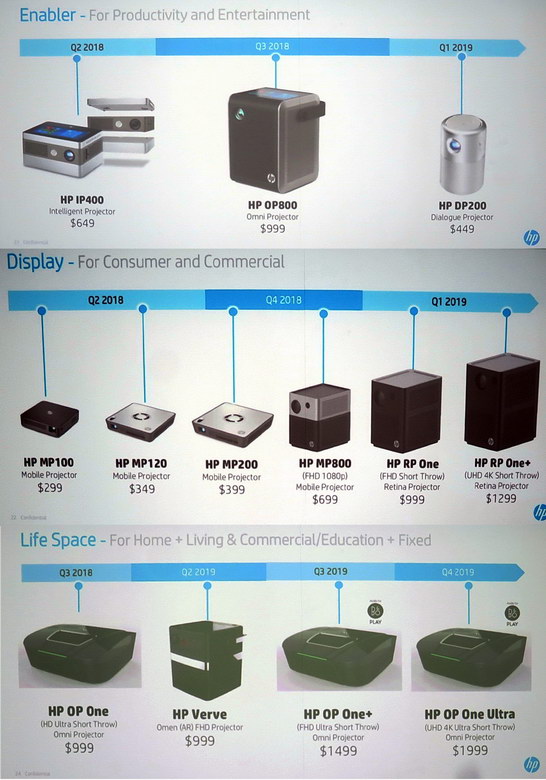 Roadmaps for HP (Aiptek) Pico/Micro Projectors shown at CE Week
Roadmaps for HP (Aiptek) Pico/Micro Projectors shown at CE Week
ThirdEye
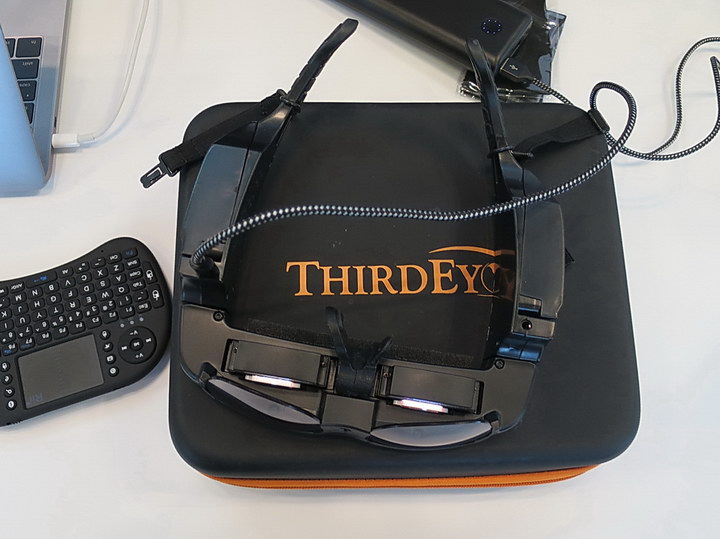 ThirdEye HMD from the bottom, sitting on its carrying case, with the optional wireless keyboard and external battery. Replaceable photochromic lenses are visible at the bottom of the unit. (Credit: M. Brennesholtz)
ThirdEye HMD from the bottom, sitting on its carrying case, with the optional wireless keyboard and external battery. Replaceable photochromic lenses are visible at the bottom of the unit. (Credit: M. Brennesholtz)
ThirdEye introduced their X1 Smart Glasses earlier this year at CES but have not been covered yet by Meko except for a brief mention after CES Unveiled in New York last fall (actually, we also reported on them from AWE a couple of weeks ago ThirdEye Open to Customisation – Man. Ed.). ThirdEye is not a recent startup, the company says “ThirdEye’s team has pedigree in the Augmented Reality space with 20+ years of advanced tech development for the Department of Defense.”
I talked to Nick Cherukuri, President at ThirdEye Gen who gave me an explanation of the X1 HMD and a demo at CE Week. These are binocular see-through AR glasses that the company is targeting at the enterprise market, not consumers. I was told that they have sold about 300 units since CES at the current MSRP of $999, down from the $1999 discussed at CES Unveiled. These units each use two 1080P (1920 x 1080) OLED microdisplays, one per eye. The HMD also includes a 13MP camera and an Android system, based on the Qualcomm Snapdragon 820, built in. At least, this is what I was told at CE Week by the ThirdEye rep, but the X1 brochure says the displays are 1280 x 720 x RGB and the processor is an Adreno 530. The built-in batteries are hot-swappable but at CE Week the company was demonstrating the unit with an external battery. While the unit comes with four built-in Android apps for enterprise use, the company is willing to develop custom software or modify the hardware for customers.
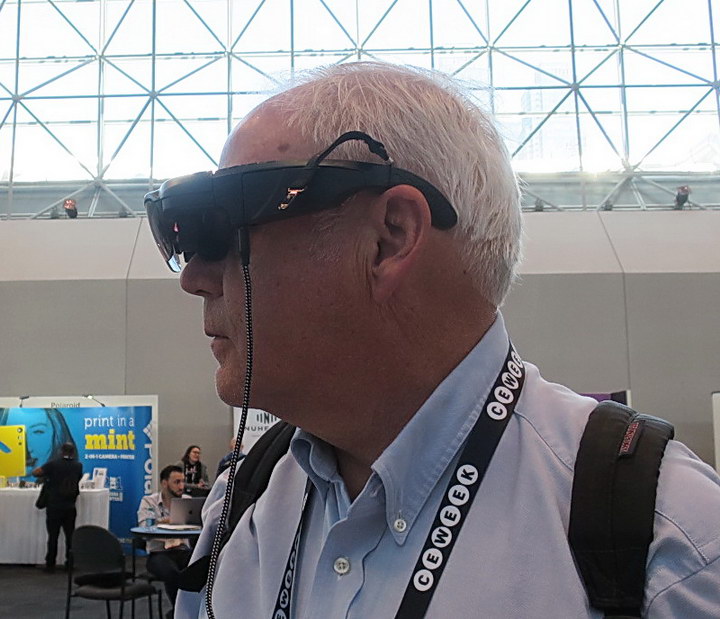 Meko’s Matt Brennesholtz trying the ThirdEye X1HMD at CE Week. (Credit: M. Brennesholtz)
Meko’s Matt Brennesholtz trying the ThirdEye X1HMD at CE Week. (Credit: M. Brennesholtz)
I tried the unit and was not overly impressed. It was heavy and somewhat clunky. While the batteries were hot-swappable so it can be worn continuously through the workday, I certainly wouldn’t want to wear the unit for eight hours. The image quality was hard to judge, but I believe the 720p rather than the 1080p version of the spec. The virtual see-through image with a 40° FOV was centered on the real world image and made the real world rather difficult to see and I certainly wouldn’t want to drive or operate machinery while wearing the glasses, or even walk around. The replaceable lenses are photochromic and automatically darken from light grey to dark grey based on the ambient sunlight. This dims the outside world to make the virtual image more visible in ambient light. These lenses can be replaced by prescription lenses, if desired.
Aura
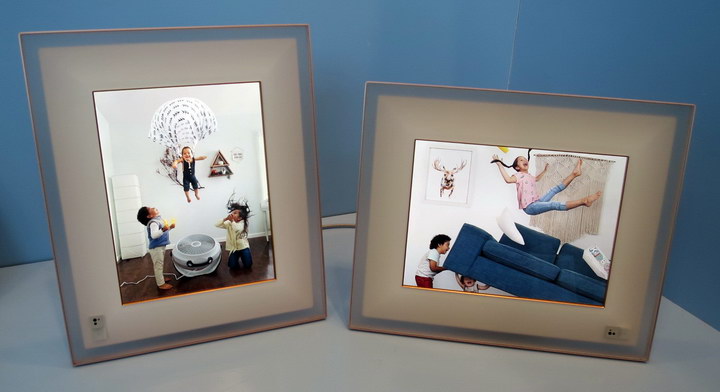 The Aura digital picture frame can be used in either portrait or landscape orientation. (Credit: M. Brennesholtz)
The Aura digital picture frame can be used in either portrait or landscape orientation. (Credit: M. Brennesholtz)
Aura was showing its digital picture frame in their booth at CE Week (Aura Reminds us of Photo Frames). This unit has a 9.7” (24.6cm) diagonal LCD image with a resolution of 1536 x 2048 and was launched during Q4 2016. The built-in frame is 10” x 11.75” (25 x 30 cm) and I was shown a non-functional next-gen unit with a narrower frame. In 2017 they sold 6,000 units, they expect to sell 15,000 units in 2018 and hope to sell 30K units in 2019, all at a MSRP of $299. The unit is wireless-only (except for power) with both Bluetooth 4.2 and Wi-Fi (802.11b/g/n, 2.4GHz) connectivity. There is no slot for a SD card and no internal memory – all images are stored in the cloud.
Currently the unit will only display still images, not videos. The unit is controlled through a smartphone app – no PC software is currently available. The only local control is a gesture sensor that allows you to move to the next image in the queue. You can also “Like” an image with a second gesture. If you are a grandparent without a smartphone and are given one of these units by a child who wants to show you pictures of grandchildren, which is likely to be a major market for the company, you are completely at the mercy of what your children want to show you. But the image quality was very good, even in the relatively high ambient light of the Javits Center.
Wi-Charge
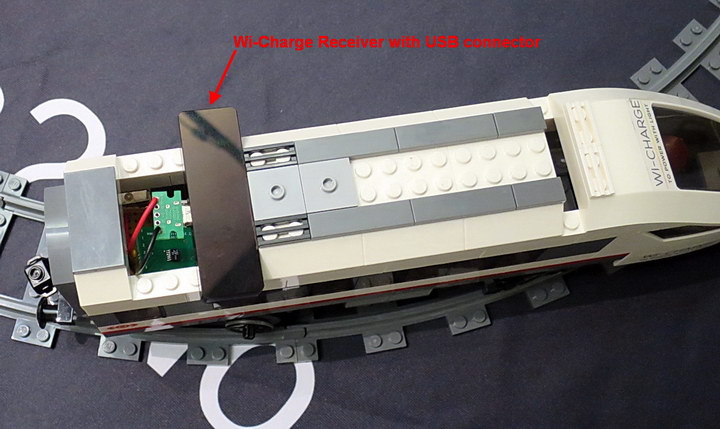 At Pepcom, Wi-Charge used a toy train to demonstrate its wireless power system. The receiver is the small black rectangle. (Credit: M. Brennesholtz)
At Pepcom, Wi-Charge used a toy train to demonstrate its wireless power system. The receiver is the small black rectangle. (Credit: M. Brennesholtz)
One very interesting bit of non-display technology shown at the Pepcom Digital Experience event was from Wi-Charge Ltd., an Israeli company. Most wireless charging systems use radio frequencies to transmit the power but Wi-Charge uses an Infra-Red (IR) laser. The Wi-Charge rep declined to say the exact wavelength but said it was in the 1µm to 3µm near-IR range. This beam is collimated and a servo mirror system is used to track the moving object being charged.
The Wi-Charge ceiling mounted transmitter can contain between 1 and 10 of these IR/servo-mirror systems and each can be used to track a separate Wi-Charge equipped device. The transmitter also contained the detection and tracking system to locate and target Wi-Charge receivers. If 10 isn’t enough devices, multiple transmitters can be used in a single room.
At Pepcom, Wi-Charge used a toy train to demonstrate its wireless power system. The train had no battery and moved solely on the 1W of power received from the transmitter. If you put your hand between the transmitter and te receiver, the train instantly stopped because the transmitter stops sending power when the receiver stops receiving it. According to the Wi-Charge rep, the tracking system ensures all the power in the collimated laser beam hits the receiver and there is no spill-over into adjacent areas. The rep said this good tracking plus the instant beam shutoff allows the system to be rated as Laser Safety Class 1, even though it involves a >1W collimated laser beam in free space in occupied areas.
When you put your hand between the transmitter and the receiver, the toy train stopped instantly. When you removed your hand, it took the transmitter 4 – 5 seconds to re-acquire the receiver, restart the power and move the train.
As a demo, the representative unplugged the receiver from the toy train and plugged it into the USB charging port on his smart phone. The train, of course, stopped. It took the transmitter perhaps 10 – 15 seconds to locate the receiver module and begin to transmit power to his smartphone.
The representative said the overall end-to-end power efficiency was about 10%. That it, it took 10W electrical input at the transmitter to provide 1W of power at the toy train or smartphone. He added that if 1W is not sufficient for a device, multiple laser/beam steering systems in a transmitter can be aimed at a single receiver to increase power throughput.
Cool! But I’m still surprised the system has a Class-1 safety rating with a 1W collimated laser beam, regardless of how many interlocks and safety features it has. –Matthew Brennesholtz

